In the bustling world of modern culinary exploration, where traditional and cutting-edge techniques intertwine, one innovation stands out among the sizzle and steam: induction cooking.
Yet, as any culinary connoisseur knows, the true magic of the kitchen lies not just in the skillful wielding of spatulas and spoons but also in the choice of the vessel itself. Enter the enigmatic realm of pans compatible with induction cooktops – a symphony of material science and design ingenuity.
From the sleek whispers of stainless steel to the hearty clang of cast iron, the question resonates: What pans truly dance in harmony with the magnetic forces of induction? Join us as we unravel this culinary puzzle, exploring the alchemy of pans that seamlessly embrace the induction revolution.
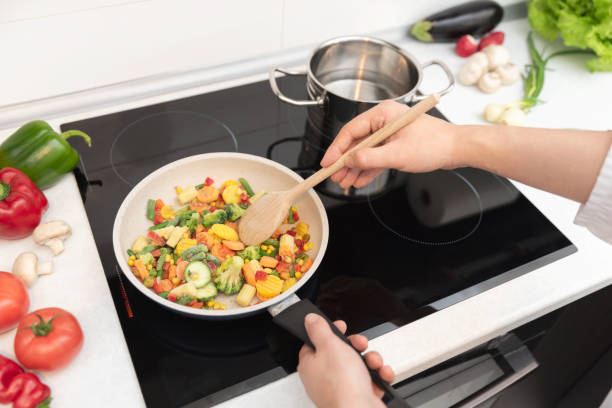
Understanding Induction Cooking
Induction cooking is a modern and efficient method of cooking that relies on electromagnetic induction to heat pots and pans directly.
Unlike traditional cooking methods that transfer heat through a flame or electric coil, induction cooktops generate a magnetic field that causes the molecules in the cookware to vibrate and produce heat.
This results in faster heating times, precise temperature control, and reduced energy consumption. Understanding induction cooking involves knowing which types of cookware are compatible (ferrous metal), how to properly adjust heat settings, and the safety precautions necessary due to the magnetic fields generated.
With its numerous benefits and sleek design, induction cooking has become increasingly popular in kitchens around the world.
What Pans Work With Induction
Induction cooking requires the use of compatible cookware, specifically pots and pans made from ferromagnetic materials such as cast iron, enameled cast iron, or stainless steel with a magnetic bottom. These materials contain iron, which allows them to respond to the magnetic field generated by the induction cooktop.
When selecting pans for induction cooking, it’s important to look for the induction-compatible symbol on the packaging or to test them with a magnet – if the magnet sticks firmly to the bottom of the pan, it should work with induction cooktops.
Non-compatible materials like aluminum, copper, or glass will not heat up on an induction cooktop, so they should be avoided.
Induction-compatible cookware typically features a flat, smooth bottom to ensure maximum contact with the cooktop surface and efficient heat transfer. Pans with a thick and heavy bottom tend to distribute heat more evenly and prevent hot spots.
Investing in a set of high-quality induction-compatible pans is essential for maximizing the benefits of induction cooking, including fast heating, precise temperature control, and energy efficiency. With the right cookware, users can enjoy all the advantages of induction cooking while creating delicious meals with ease.
1. Cast-Iron
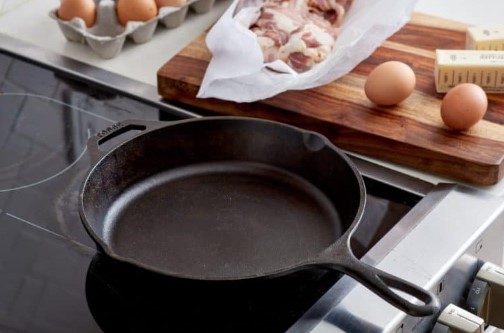
Cast iron pans are excellent choices for induction cooking due to their compatibility with the magnetic field generated by induction cooktops. These pans are made from molten iron poured into a mold, resulting in a durable and heavy-duty cooking vessel that retains heat well and distributes it evenly.
Cast iron pans have a naturally rough surface that improves over time with seasoning, creating a non-stick cooking surface that is ideal for various types of food.
When using cast iron pans on an induction cooktop, it’s essential to ensure that the bottom of the pan is flat and smooth to maintain proper contact with the cooktop surface and maximize heat transfer. Cast iron pans can withstand high cooking temperatures, making them versatile for searing, frying, baking, and even grilling.
One of the key advantages of using cast iron pans for induction cooking is their ability to retain heat, which allows for consistent cooking temperatures and excellent searing capabilities.
Cast iron pans also provide an added source of dietary iron, as small amounts of iron can leach into the food during cooking, which can be beneficial for individuals with iron deficiencies.
Overall, cast iron pans are a reliable and versatile option for induction cooking, offering durability, even heat distribution, and excellent cooking performance for a wide range of recipes. With proper care and maintenance, cast iron pans can last a lifetime and become cherished heirlooms passed down through generations.
2. Carbon Steel
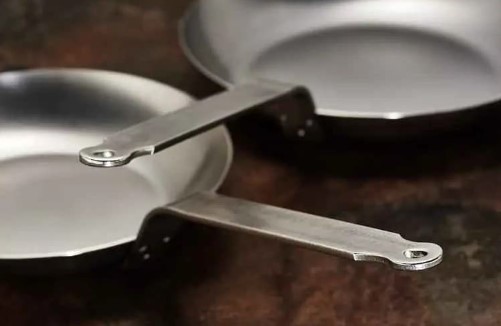
Carbon steel pans are another excellent choice for induction cooking, offering many of the same benefits as cast iron pans while being lighter and more responsive to temperature changes. These pans are made from a combination of iron and carbon, with a smooth cooking surface that develops a natural non-stick patina over time with proper seasoning.
Like cast iron, carbon steel pans are compatible with induction cooktops due to their ferromagnetic properties, allowing for efficient heat transfer and consistent cooking results. Carbon steel pans heat up quickly and evenly, making them ideal for tasks such as searing, sautéing, and stir-frying.
One of the main advantages of carbon steel pans is their lightweight construction, which makes them easier to handle and maneuver compared to heavier cast iron pans. This makes carbon steel pans particularly well-suited for tasks that require frequent tossing and flipping, such as stir-frying vegetables or flipping pancakes.
Carbon steel pans also have excellent heat retention properties, allowing them to maintain consistent cooking temperatures even when cooking at high heat. This makes them versatile for a wide range of cooking techniques and recipes, from searing meats to baking pizzas.
Overall, carbon steel pans are a versatile and durable option for induction cooking, offering fast and even heating, lightweight construction, and excellent cooking performance. With proper care and maintenance, carbon steel pans can provide many years of reliable service in the kitchen.
3. Stainless Steel
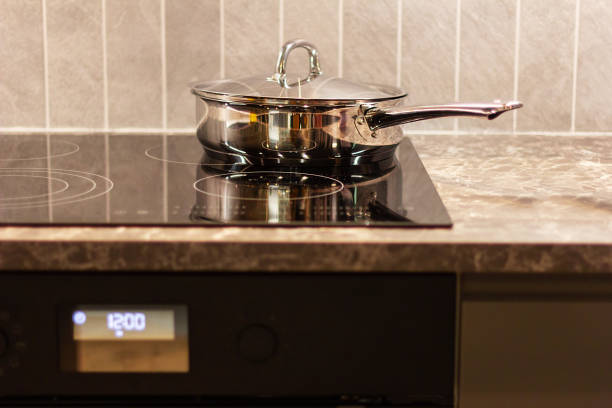
Stainless steel pans are a popular choice for induction cooking due to their versatility, durability, and sleek appearance. These pans are made from a combination of iron, carbon, and chromium, with the addition of other metals like nickel or molybdenum to enhance their strength and corrosion resistance.
Stainless steel pans typically have a smooth and polished cooking surface that is easy to clean and maintain. While stainless steel itself is not inherently magnetic, many stainless steel pans feature an added layer of magnetic material on the bottom, making them compatible with induction cooktops.
One of the key advantages of stainless steel pans is their excellent heat distribution properties, allowing for even cooking results without hot spots. Stainless steel pans are also non-reactive, meaning they won’t impart any metallic flavors or react with acidic ingredients, making them suitable for a wide range of cooking tasks, including simmering sauces and braising meats.
Another benefit of stainless steel pans is their versatility and durability. These pans can withstand high cooking temperatures and are oven-safe, making them suitable for tasks such as searing, roasting, and baking. Stainless steel pans are also dishwasher-safe, making them easy to clean and maintain.
While stainless steel pans may not have the same heat retention properties as cast iron or carbon steel pans, they offer excellent corrosion resistance and longevity. With proper care and maintenance, stainless steel pans can last a lifetime, making them a worthwhile investment for any kitchen.
Overall, stainless steel pans are a reliable and versatile option for induction cooking, offering even heat distribution, durability, and ease of maintenance. Whether you’re sautéing vegetables, searing meats, or simmering sauces, stainless steel pans are sure to deliver excellent cooking performance for years to come.
Other Pans
In addition to cast iron, carbon steel, and stainless steel pans, there are other types of pans that can be used for induction cooking, although they may have some limitations or considerations to keep in mind.
- Enameled Cast Iron: Enameled cast iron pans combine the heat retention and even heating properties of cast iron with a smooth, non-reactive enamel coating. While the enamel itself may not be magnetic, many enameled cast iron pans feature a magnetic bottom, making them compatible with induction cooktops. These pans are versatile and suitable for a wide range of cooking tasks, including braising, stewing, and baking.
- Copper: Copper pans are known for their excellent heat conductivity, allowing for precise temperature control and quick response to changes in heat. However, pure copper is not magnetic and is therefore not compatible with induction cooktops. Some copper pans feature an added layer of magnetic material on the bottom, making them suitable for use with induction cooktops, but they may not offer the same level of heat conductivity as traditional copper pans.
- Aluminum: Aluminum pans are lightweight and conduct heat well, making them ideal for tasks that require quick and even heating, such as frying and sautéing. However, aluminum is not magnetic and is therefore not compatible with induction cooktops. Some aluminum pans may feature a magnetic bottom or an added layer of magnetic material, but they may not perform as efficiently on an induction cooktop compared to other materials.
- Non-stick: Non-stick pans, typically made from aluminum or stainless steel with a non-stick coating, are popular for their ease of use and convenient cleanup. While many non-stick pans are not compatible with induction cooktops due to their non-magnetic construction, there are some options available with a magnetic bottom or an added layer of magnetic material. However, it’s essential to ensure that the non-stick coating can withstand the high heat generated by induction cooking without deteriorating or releasing harmful fumes.
When selecting pans for induction cooking, it’s crucial to choose ones that are compatible with induction cooktops and suitable for your specific cooking needs. Whether you prefer the heat retention of cast iron, the lightweight versatility of carbon steel, or the durability of stainless steel, there are plenty of options available to help you make delicious meals with your induction cooktop.
The Magnet Test
The magnet test is a simple method to determine whether a pan is compatible with induction cooktops. Since induction cooktops rely on magnetic fields to generate heat, only pans made from ferromagnetic materials will work on them. Here’s how to perform the magnet test:
- Place a magnet, such as a refrigerator magnet or a magnetic strip, on the bottom of the pan.
- If the magnet sticks firmly to the bottom of the pan, it indicates that the pan is made from a ferromagnetic material and should be compatible with induction cooktops.
- If the magnet does not stick or only sticks weakly to the bottom of the pan, it suggests that the pan is not made from a ferromagnetic material and may not work on an induction cooktop.
It’s essential to note that while the magnet test is a useful initial screening method, it may not be foolproof. Some pans may have a magnetic bottom or an added layer of magnetic material that allows them to pass the magnet test but may still not perform optimally on an induction cooktop.
Some non-magnetic materials, such as copper or aluminum, may be used in combination with a magnetic base to create pans that are compatible with induction cooktops. Therefore, it’s always a good idea to check the manufacturer’s specifications or labeling to ensure compatibility before purchasing a pan for use on an induction cooktop.

Induction-Compatible Sign
The induction-compatible sign is a symbol often found on the packaging or bottom of cookware to indicate that it is suitable for use on induction cooktops. It typically consists of a stylized coil or wave icon, sometimes accompanied by the words “induction compatible” or similar language.
This symbol serves as a helpful indicator for consumers when selecting cookware for their induction cooktops, as it ensures that the pans have been specifically designed or modified to work with the magnetic fields generated by induction cooking technology.
By choosing cookware with the induction-compatible sign, users can be confident that their pans will heat up efficiently and evenly on their induction cooktops, resulting in consistent cooking results.
When shopping for cookware, it’s essential to look for the induction-compatible sign or check the product specifications to confirm compatibility with induction cooktops. This can help prevent issues such as uneven heating or ineffective heat transfer, ensuring a positive cooking experience with induction technology.
Factors to Consider When Choosing Induction-Compatible Pans
When choosing induction-compatible pans, several factors should be considered to ensure optimal performance and suitability for your cooking needs:
Size and shape of the cookware
Consider the size and shape of the pans in relation to your induction cooktop and the types of meals you typically prepare. Choose pans that fit comfortably on the cooktop and have sufficient capacity for your cooking tasks.
Consider the shape of the pans – for example, straight-sided pans may be better for tasks like frying, while sloped-sided pans may be more suitable for tasks like sautéing or flipping ingredients.
Thickness and material quality
Pay attention to the thickness and material quality of the pans, as these factors can affect heat distribution, durability, and cooking performance. Look for pans made from high-quality materials such as stainless steel, cast iron, or carbon steel, with a thick and sturdy construction that promotes even heating and prevents warping.
Avoid pans that are too thin or lightweight, as they may not retain heat well or withstand high cooking temperatures.
Handle design and heat resistance
Consider the design and heat resistance of the pan handles, as they play a crucial role in comfort and safety during cooking. Choose pans with ergonomic handles that are comfortable to hold and securely attached to the pan.
Look for handles made from heat-resistant materials such as stainless steel or silicone, which remain cool to the touch during cooking and can be safely used in the oven or broiler if needed.
Budget considerations
Finally, consider your budget when selecting induction-compatible pans. While high-quality cookware may come with a higher price tag, it often offers better durability, performance, and long-term value.
However, there are also budget-friendly options available that provide decent performance for everyday cooking needs. Evaluate your priorities and cooking habits to determine the right balance between quality and affordability for your needs.
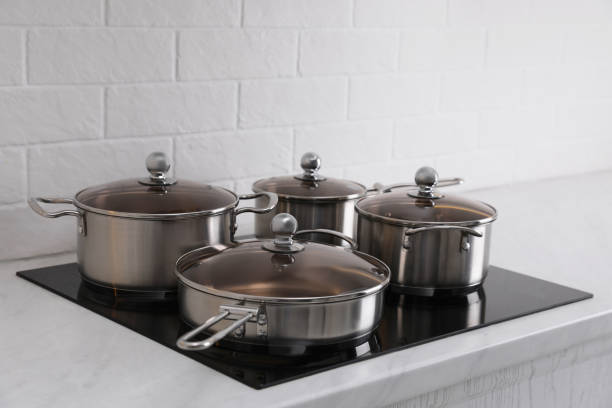
Tips for Optimizing Induction Cooking Experience
To optimize your induction cooking experience, consider the following tips:
Preheating techniques for induction cookware
Unlike traditional cooking methods, induction cooktops heat up quickly, so preheating your pans is not always necessary. However, for tasks like searing meats or achieving a crisp crust on foods, preheating the pan can help.
To preheat your pan, simply place it on the induction cooktop and select the desired temperature setting. Once the pan is heated, add oil or other cooking fat and proceed with cooking.
Adjusting cooking temperatures and settings
Induction cooktops offer precise temperature control, allowing you to adjust the heat settings with accuracy. Experiment with different temperature settings to find the optimal heat level for your cooking tasks.
Keep in mind that induction cookware heats up quickly and retains heat well, so you may need to adjust the temperature lower than you would with other cooking methods to prevent burning or overcooking.
Cleaning and maintenance tips for induction-compatible pans
To keep your induction-compatible pans in top condition, follow these cleaning and maintenance tips:
- Allow the pans to cool completely before cleaning to avoid warping or damage.
- Use mild dish soap and warm water to clean the pans, avoiding abrasive cleaners or scrubbers that can scratch the surface.
- For stubborn stains or residue, soak the pans in warm, soapy water or use a non-abrasive cleaning solution.
- Avoid using metal utensils or abrasive cleaning tools that can scratch the surface of the pans.
- Dry the pans thoroughly after washing to prevent water spots or corrosion.
Periodically re-season cast iron or carbon steel pans to maintain their non-stick - properties and prevent rusting.
Store the pans in a dry, well-ventilated area to prevent moisture buildup and corrosion.
By following these tips, you can optimize your induction cooking experience and enjoy delicious meals with ease and efficiency.
Troubleshooting Common Issues with Induction Cookware
To troubleshoot common issues with induction cookware, consider the following:
Recognizing and addressing compatibility issues
If your cookware is not heating up or performing as expected on your induction cooktop, it may be due to compatibility issues.
Check to ensure that your pans are made from ferromagnetic materials such as stainless steel, cast iron, or carbon steel, and that they have a flat and smooth bottom for optimal contact with the cooktop surface.
If your cookware is not compatible with induction cooking, consider investing in induction-compatible pans or using a converter disc to make non-compatible pans usable on your induction cooktop.
Tips for preventing damage to induction cooktops and pans:
To avoid damage to your induction cooktop and pans, follow these tips:
- Avoid dragging or sliding pans across the cooktop surface, as this can scratch the glass and damage the heating elements.
- Use caution when using heavy or oversized pans, as they can put excessive strain on the cooktop and potentially cause damage.
- Clean up spills and food debris promptly to prevent them from burning onto the cooktop surface.
- Avoid using abrasive cleaners or scrubbers that can scratch the surface of the cooktop or damage the pans.
- Use cookware with flat and smooth bottoms to ensure optimal contact with the cooktop surface and efficient heat transfer.
Resources for additional assistance and support
If you encounter persistent issues with your induction cookware or cooktop, consider reaching out to the manufacturer for assistance.
Many manufacturers offer troubleshooting guides, FAQs, and customer support services to help address common issues and provide solutions. Online forums, community groups, and social media platforms can be valuable resources for seeking advice and troubleshooting tips from other users who have experience with induction cooking.
By recognizing compatibility issues, taking steps to prevent damage, and seeking assistance when needed, you can troubleshoot common issues with induction cookware and enjoy a positive cooking experience with your induction cooktop.
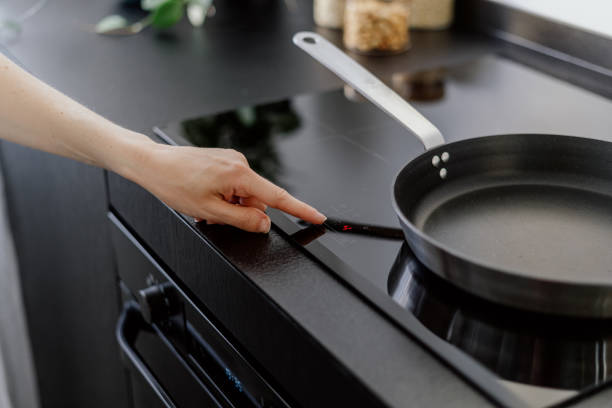
Frequently Asked Questions (FAQs) – What Pans Work With Induction
What makes induction cooking such an exciting culinary experience?
Induction cooking offers unparalleled speed and precision, heating pans directly and rapidly, resulting in more efficient cooking and tastier meals.
How do I know if my pans are compatible with induction cooktops?
Look for pans made from ferrous materials like cast iron, stainless steel, or magnetic-grade stainless steel. These materials ensure optimal performance and seamless compatibility with your induction cooktop.
Can I use my favorite nonstick pans with induction cooking?
Absolutely! Many manufacturers now offer nonstick pans with a magnetic base, making them perfectly suitable for induction cooking while retaining their superb nonstick qualities.
Are there any benefits to switching to induction-compatible pans?
Certainly! Induction-compatible pans not only elevate your cooking experience with faster heat-up times and precise temperature control but also promote energy efficiency, helping you cook more sustainably.
Will using induction-compatible pans enhance the flavors of my dishes?
Absolutely! Induction cooking provides even heat distribution, ensuring that your meals are cooked to perfection, enhancing flavors, textures, and overall culinary delight.
How can I ensure longevity and performance with my induction-compatible pans?
Proper care and maintenance are key. Avoid overheating your pans, use gentle cleaning methods, and store them appropriately to ensure they remain in top-notch condition for years to come.
Can I use induction-compatible pans for a variety of cooking techniques?
Yes! Whether you’re sautéing, frying, boiling, or simmering, induction-compatible pans offer versatility and reliability for all your culinary endeavors.
Will investing in induction-compatible pans save me time in the kitchen?
Absolutely! The rapid and precise heating of induction cooktops, combined with compatible pans, streamlines your cooking process, allowing you to prepare meals faster and with greater efficiency.
Can induction-compatible pans help me become a better cook?
Definitely! With the precise temperature control and even heat distribution provided by induction cooking, coupled with compatible pans, you’ll have greater control over your recipes, empowering you to explore new techniques and flavors with confidence.
How does using induction-compatible pans contribute to a more sustainable kitchen?
By harnessing the energy efficiency of induction cooking and pairing it with compatible pans, you’ll reduce energy waste and environmental impact, making small yet significant steps towards a greener culinary journey.
Conclusion
In conclusion, understanding the compatibility of pans with induction cooktops is essential for maximizing cooking efficiency and safety in modern kitchens.
By selecting the appropriate materials and designs, such as those made of ferrous metals like stainless steel or cast iron, users can harness the full potential of their induction cookers while ensuring longevity and performance of both their cookware and appliances.
Moreover, advancements in technology continue to expand the range of options available to consumers, offering greater flexibility and convenience in culinary pursuits.
With careful consideration and informed choices, individuals can confidently navigate the diverse landscape of induction-compatible pans, enhancing their cooking experiences and achieving delicious results with ease.